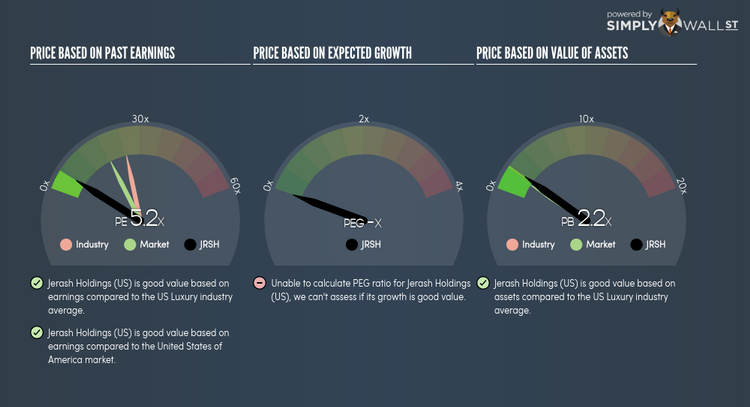Should You Be Tempted To Buy Jerash Holdings (US) Inc (NASDAQ:JRSH) At Its Current PE Ratio?

Jerash Holdings (US) Inc (NASDAQ:JRSH) is trading with a trailing P/E of 5.2x, which is lower than the industry average of 24.8x. While this makes JRSH appear like a great stock to buy, you might change your mind after I explain the assumptions behind the P/E ratio. In this article, I will explain what the P/E ratio is as well as what you should look out for when using it. See our latest analysis for Jerash Holdings (US)
What you need to know about the P/E ratio
The P/E ratio is a popular ratio used in relative valuation since earnings power is a key driver of investment value. By comparing a stock’s price per share to its earnings per share, we are able to see how much investors are paying for each dollar of the company’s earnings.
P/E Calculation for JRSH
Price-Earnings Ratio = Price per share ÷ Earnings per share
JRSH Price-Earnings Ratio = $7.76 ÷ $1.499 = 5.2x
The P/E ratio isn’t a metric you view in isolation and only becomes useful when you compare it against other similar companies. We preferably want to compare the stock’s P/E ratio to the average of companies that have similar features to JRSH, such as capital structure and profitability. A quick method of creating a peer group is to use companies in the same industry, which is what I will do. JRSH’s P/E of 5.2x is lower than its industry peers (24.8x), which implies that each dollar of JRSH’s earnings is being undervalued by investors. Therefore, according to this analysis, JRSH is an under-priced stock.
Assumptions to be aware of
While our conclusion might prompt you to buy JRSH immediately, there are two important assumptions you should be aware of. The first is that our “similar companies” are actually similar to JRSH, or else the difference in P/E might be a result of other factors. For example, if you are comparing lower risk firms with JRSH, then its P/E would naturally be lower than its peers, as investors would value those with lower risk at a higher price. The second assumption that must hold true is that the stocks we are comparing JRSH to are fairly valued by the market. If this does not hold true, JRSH’s lower P/E ratio may be because firms in our peer group are overvalued by the market.
What this means for you:
You may have already conducted fundamental analysis on the stock as a shareholder, so its current undervaluation could signal a good buying opportunity to increase your exposure to JRSH. Now that you understand the ins and outs of the PE metric, you should know to bear in mind its limitations before you make an investment decision. Remember that basing your investment decision off one metric alone is certainly not sufficient. There are many things I have not taken into account in this article and the PE ratio is very one-dimensional. If you have not done so already, I highly recommend you to complete your research by taking a look at the following:
Financial Health: Is JRSH’s operations financially sustainable? Balance sheets can be hard to analyze, which is why we’ve done it for you. Check out our financial health checks here.
Valuation: What is JRSH worth today? Is the stock undervalued, even when its growth outlook is factored into its intrinsic value? The intrinsic value infographic in our free research report helps visualize whether JRSH is currently mispriced by the market.
Other High-Performing Stocks: Are there other stocks that provide better prospects with proven track records? Explore our free list of these great stocks here.
To help readers see pass the short term volatility of the financial market, we aim to bring you a long-term focused research analysis purely driven by fundamental data. Note that our analysis does not factor in the latest price sensitive company announcements.
The author is an independent contributor and at the time of publication had no position in the stocks mentioned.

